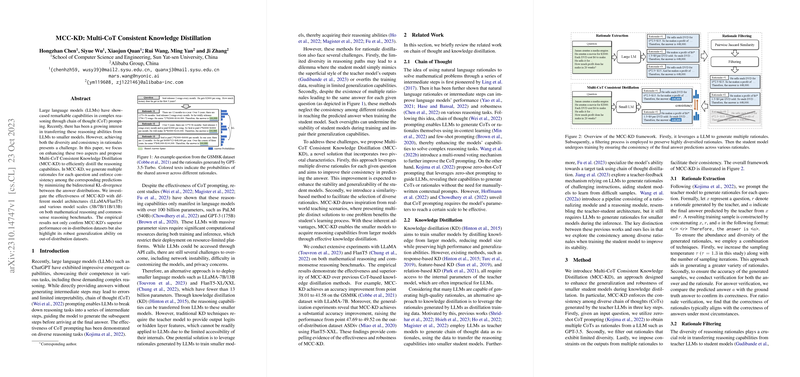Analyses and Insights on "MCC-KD: Multi-CoT Consistent Knowledge Distillation"
In the paper titled "MCC-KD: Multi-CoT Consistent Knowledge Distillation," Chen et al. propose a novel approach to transfer complex reasoning capabilities from LLMs to smaller models using Multi-CoT Consistent Knowledge Distillation (MCC-KD). This approach primarily addresses two key challenges associated with knowledge distillation for reasoning tasks: diversity and consistency of generated rationales.
Background
Chain of Thought (CoT) prompting has been recognized as an effective method to enhance the reasoning abilities of LLMs. This technique decomposes complex tasks into a series of intermediate steps or rationales. Nonetheless, prior studies have shown that such advanced reasoning capabilities only emerge in models with over 100 billion parameters. This necessitates significant computational resources, which limit the deployment of these models on resource-constrained platforms.
MCC-KD Approach
Rationale Extraction and Filtering
MCC-KD leverages CoT prompting to generate multiple rationales for each question using a teacher LLM like GPT-3.5-Turbo. To ensure diversity, it employs a filtering method using Jaccard similarity on N-gram segments, which enhances diversity by retaining only highly diversified rationales. This filtering process mitigates the issue of similar or repetitive rationales typically generated even at higher sampling temperatures.
Incorporating Consistency
To ensure that the distilled reasoning capabilities are stable and generalizable, MCC-KD enforces consistency among the predictions of the student model. This is done by minimizing the bidirectional KL-divergence between the answer distributions generated from diverse rationales for the same question. The training objective combines the traditional cross-entropy loss with this consistency-enforcing KL-divergence term, weighted by a hyperparameter α.
Numerical Results and Implications
Performance Evaluation
Empirical results demonstrate that MCC-KD outperforms existing CoT-based knowledge distillation methods across different model architectures (LLaMA and FlanT5) and scales (3B, 7B, 11B, and 13B parameters) on both mathematical and commonsense reasoning benchmarks. For instance, with LLaMA-7B, MCC-KD achieves an accuracy improvement from 38.01 to 41.58 on the GSM8K dataset. In out-of-distribution (OOD) generalization tasks, which are crucial for robustness, MCC-KD also demonstrates substantial improvements. For example, the accuracy on the ASDiv OOD dataset improves from 47.69 to 49.52 when utilizing FlanT5-XXL.
Ablation Studies
Ablation studies show that removing the multi-CoT consistency constraint significantly degrades performance, indicating its critical role in enhancing model stability. Similarly, omitting the rationale filtering step results in noticeable performance drops, affirming the importance of diversity in the rationales. The paper also experimentally substantiates the effectiveness of leveraging multiple rationales (with K set to 5), balancing computational efficiency and model performance.
Implications and Future Directions
The findings of this paper imply that modeling consistency among diverse reasoning paths is pivotal for effective knowledge distillation in reasoning tasks. This insight could catalyze further research into consistency regularization techniques in other domains of AI and machine learning.
Theoretical Implications
The theoretically grounded approach (using KL-divergence for consistency) enhances our understanding of how reasoning paths contribute to model generalizability and stability.
Practical Implications
Practically, MCC-KD facilitates the deployment of resource-efficient models capable of performing complex reasoning tasks, widening the accessibility to such advanced AI capabilities in real-world applications.
Future Research
Future developments could explore the application of MCC-KD to a wider array of tasks beyond mathematical and commonsense reasoning. Comparative studies with different LLM architectures as teachers, alongside evaluations on additional OOD datasets, could provide deeper insights. Given the strong empirical results, extending this work to consider hybrid models including pre-trained and specialized modules might reveal new possibilities for enhancing inference capabilities.
In summation, the proposed MCC-KD framework underscores the significance of maintaining rationale diversity and consistency for distilling reasoning abilities into smaller models, marking a valuable contribution to the field of AI and knowledge distillation. The methodology and findings pave the way for the development of more efficient yet competent AI systems, crucial for broadening the practical applicability of state-of-the-art AI technologies.
